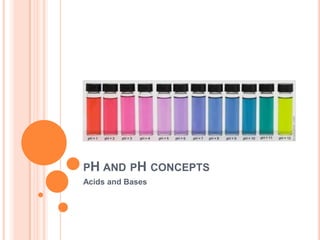ppt_acids and bases
- 1. PH AND PH CONCEPTS Acids and Bases
- 2. PH F.Y.I.
- 3. PH  pH is a measure of the activity of the hydrogen ion  pure water has a pH very close to 7 at 25°C  solutions with a pH less than 7 are acidic and solutions with a pH greater than 7 are basic or alkaline
- 4. PH
- 5. THE PH SCALE The pH scale measure s how acidic or basic a substance is. The pH scale ranges from 0 to 14.
- 6. PH ÔÇ¢ measurement of pH for aqueous solutions can be done with a glass electrode and a pH meter, or using indicators. ÔÇ¢ pH measurements are important in medicine, biology, chemistry, agriculture, forestry, food science, environmental science, oceanography, civil engineering, and many other applications.
- 7. WAYS OF MEASURING PH ÔÇ¢ Measuring pH Using an Indicator This category basically includes two methods: 1. comparing the standard color corresponding to a known pH with the color of an indicator immersed in the test liquid using buffer solution 2. preparing pH test paper which is soaked in the indicator, then immersing the paper in the test liquid and comparing its color with the standard color.
- 8. WAYS OF MEASURING PH This method is simple, but prone to error. A high degree of accuracy cannot be expected. Various errors include; - Error due to high salt concentration in the test liquid - Error due to the temperature of the test liquid - Error due to organic substances in the test liquid
- 9. TITRATION USING PHENOLPHTHALEIN
- 10. WAYS OF MEASURING PH Natural Indicators - there are many common household products and garden plants that can be used as pH indicators - most plants contain pH sensitive anthocyanins
- 11. WAYS OF MEASURING PH ÔÇ¢ Metal-electrode methods (including the hydrogen- electrode method, quinhydron-electrode method and antimony-electrode method) 1. Hydrogen-Electrode Method - made by adding platinum black to platinum wire or a platinum plate - it is immersed in the test solution and an electric charge is applied to the solution and platinum black with hydrogen gas
- 12. WAYS OF MEASURING PH - is a standard among the various methods for measuring pH - not appropriate for daily use because of the effort and expense involved
- 13. WAYS OF MEASURING PH 2. Quinhydron-Electrode Method - involves immersing the tip of a polished antimony rod into a test solution, also immersing a reference electrode, and measuring pH from the difference in potential between them - was once widely used because the apparatus is sturdy and easy to handle - results vary depending on the degree of polish of the electrode, and reproducibility is low.
- 14. WAYS OF MEASURING PH 3. Antimony-Electrode Method - involves immersing the tip of a polished antimony rod into a test solution, also immersing a reference electrode, and measuring pH from the difference in potential between them - the apparatus is sturdy and easy to handle - results vary depending on the degree of polish of the electrode, and reproducibility is low.
- 15. WAYS OF MEASURING PH ÔÇ¢ Glass-Electrode Method - pH measurement is applied to plating, etching of metal surfaces and the manufacture of batteries - most widely used for pH measurement because the balancing time of electrical potential is short, it has high reproducibility - it is rarely affected by oxidizing and reducing agents, and it can measure pH of various solutions.















